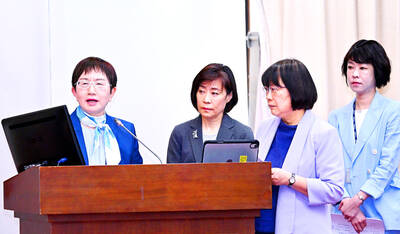The government’s business climate monitor last month remained “blue” for the eighth straight month as major economic barometers displayed negative cyclical movements, in line with a recessionary state, the National Development Council (NDC) said yesterday.
The total value of the nine monitoring indicators gained 1 point to 13, thanks to rallies in the local bourse as local tech stocks benefited from their participation in the supply of artificial intelligence (AI) devices, the council said.
“The stock closing prices flashed the first ‘green’ light in 15 months, suggesting the business landscape would grow brighter,” the council said.

Photo: CNA
The council uses a five-color system to portray the nation’s economic health, with “green” signifying steady growth, “red” suggesting a boom and “blue” reflecting a recession. Dual colors suggest transition to a stronger or weaker state. Stock prices are widely believed to lead real business performance by several months.
The remaining eight constituent measures stayed unchanged from one month earlier, the council said, adding that the business climate monitor could emerge from “blue” territory later this year.
The index of leading indicators, which seeks to project the economic situation in the next six months, shed another 0.63 percent from one month earlier to 98.56, the council said.
The readings on labor accession and business confidence showed positive cyclical movements, in addition to stock prices, it said.
The partial uptick came even though declines in imports of semiconductor equipment, export orders and building floor areas widened, the council said.
The index of coincident indicators, which reflects the current economic situation, increased 0.04 percent to 93.61, an encouraging sign, it said.
The values on non-farm payroll and electricity usage increased, but industrial output, imports of electrical and machinery equipment, exports and manufacturing sales continued to decline, it said.
The council stood by the view that the nation’s GDP growth this year would exceed 2 percent as the Directorate-General of Budget, Accounting and Statistics projected in May. The statistics agency is to release data on the second quarter tomorrow.

‘SWASTICAR’: Tesla CEO Elon Musk’s close association with Donald Trump has prompted opponents to brand him a ‘Nazi’ and resulted in a dramatic drop in sales Demonstrators descended on Tesla Inc dealerships across the US, and in Europe and Canada on Saturday to protest company chief Elon Musk, who has amassed extraordinary power as a top adviser to US President Donald Trump. Waving signs with messages such as “Musk is stealing our money” and “Reclaim our country,” the protests largely took place peacefully following fiery episodes of vandalism on Tesla vehicles, dealerships and other facilities in recent weeks that US officials have denounced as terrorism. Hundreds rallied on Saturday outside the Tesla dealership in Manhattan. Some blasted Musk, the world’s richest man, while others demanded the shuttering of his

ADVERSARIES: The new list includes 11 entities in China and one in Taiwan, which is a local branch of Chinese cloud computing firm Inspur Group The US added dozens of entities to a trade blacklist on Tuesday, the US Department of Commerce said, in part to disrupt Beijing’s artificial intelligence (AI) and advanced computing capabilities. The action affects 80 entities from countries including China, the United Arab Emirates and Iran, with the commerce department citing their “activities contrary to US national security and foreign policy.” Those added to the “entity list” are restricted from obtaining US items and technologies without government authorization. “We will not allow adversaries to exploit American technology to bolster their own militaries and threaten American lives,” US Secretary of Commerce Howard Lutnick said. The entities

Minister of Finance Chuang Tsui-yun (莊翠雲) yesterday told lawmakers that she “would not speculate,” but a “response plan” has been prepared in case Taiwan is targeted by US President Donald Trump’s reciprocal tariffs, which are to be announced on Wednesday next week. The Trump administration, including US Secretary of the Treasury Scott Bessent, has said that much of the proposed reciprocal tariffs would focus on the 15 countries that have the highest trade surpluses with the US. Bessent has referred to those countries as the “dirty 15,” but has not named them. Last year, Taiwan’s US$73.9 billion trade surplus with the US

Prices of gasoline and diesel products at domestic gas stations are to fall NT$0.2 and NT$0.1 per liter respectively this week, even though international crude oil prices rose last week, CPC Corp, Taiwan (台灣中油) and Formosa Petrochemical Corp (台塑石化) said yesterday. International crude oil prices continued rising last week, as the US Energy Information Administration reported a larger-than-expected drop in US commercial crude oil inventories, CPC said in a statement. Based on the company’s floating oil price formula, the cost of crude oil rose 2.38 percent last week from a week earlier, it said. News that US President Donald Trump plans a “secondary